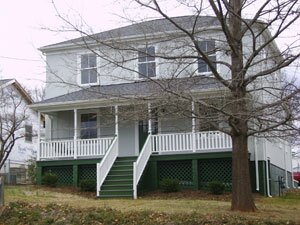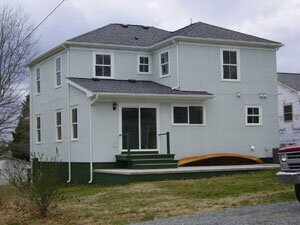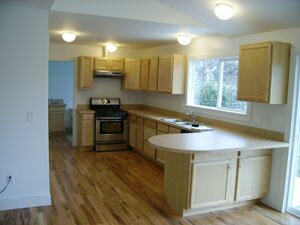REAL ESTATE- ON THE BLOCK- 1920s revival: Yet modern plan and features abound

PHOTOS BY PETER GROSS
ADDRESS: 817 Stonehenge Avenue
NEIGHBORHOOD: Belmont
ASKING: $430,000
ASSESSMENT: $56,100 (land only, new house not appraised)
YEAR BUILT: 2008
SIZE: 2,000 fin. sq. ft.
LAND: 0.14 acres
CURB APPEAL: 8 out of 10
LISTED BY: Owner, Dan Widmer, 508-360-1317
Some people demand gaudy houses that stand out from the crowd, trumpeting their presence to the world. Others prefer the anonymity of blending into the generic-looking models in most subdivisions. The builder of this week's house challenged himself to build a sophisticated Belmont residence from the ground up that looks like it has always been part of the scenery.
After buying and tearing down the original house on the site, the owner carefully constructed the replacement to incorporate modern building materials and techniques while conforming to an older sense of style, paying particular attention to energy conservation.
In addition to a dual-source heating system (a heat pump and a gas back-up furnace), the exterior walls have been applied using a Sto exterior insulated finishing system to retain heat while appearing to be a typical Belmont stucco finish. Of course, some classic roles will always be filled best by the traditional stand-bys also found in the house, like the hardwood floors and ceramic tile bathrooms. Although there are some unfinished interior details like doors and closet shelves, none of the required work appears serious enough to delay a closing.
The foundation of the house is the only part of the original structure remaining, and it has been incorporated into an area under the house that's too spacious to be called a crawlspace but too low-ceilinged to be called a basement. It's well-lighted and provides a place for the water heater, but there's no access from inside the house; to get in, you have to go outside. The rest of the house has been completely redone with a new floor plan. A shed on the property has been retained, but new doors have given it a facelift.
The dominant feature of the first floor is the large open space running the length of the house and breaking left at the back wall to turn into a kitchen. Functionally, it's designed as a great room that will serve as living room, dining room, and/or greeting room, depending on the owner's whim.
The attached kitchen is bright and roomy, with a good-size counter and a breakfast bar that extends out to separate the cooking space visually from the rest of the room. A closet off the kitchen provides pantry space, while a half bath containing the washer and dryer and a sink with an extra-deep basin is ready for clean-up duty. Although it could be viewed as a mud room, using it for that would mean tracking mud through the kitchen.
A swing on the covered porch will be good for summer people-watching. In colder seasons– or for more discreet peepers– lots of windows provide views from three sides of the house. A panoramic window above the kitchen sink lets parents keep an eye on their children in the back yard, while windows along the front and side let a would-be Gladys Kravitz (remember the nosy neighbor from Bewitched?) survey goings-on in the rest of the neighborhood. The glass door leading onto the concrete patio behind the house provides functionality along with scenery.
The master suite is in the corner of the house on the first floor, with a bedroom, bathroom, and two closets, but it's accessed by a doorway positioned in the middle of the great room and at the foot of the stairs.
Upstairs, the second-floor landing is striking for its size and vantage point. Slightly larger than one of the upstairs bedrooms, the landing could easily fit a couch and a small entertainment center without crowding the space. It's also at a corner of the house with views of tree-lined hills in the distance, far beyond the neighboring houses. It makes for a good upstairs focal point that serves as a neutral ground outside the private space of the bedrooms.
All the second-floor bedrooms offer window access to a shallow-pitched roof as a safety feature in case of fire. While it's an intentional feature that explains why the roof is lower at one of the back corners, the extra safety precautions may be less noticeable to potential buyers than ceiling fans in all the rooms.
The elevated lot and the prominent corner location will encourage the new owners to see and be seen. At the same time, to keep the place from sticking out like a sore thumb, the house follows the 1920's style so popular in the neighborhood.
Each week, a brave local seller invites the Hook to provide an impartial, warts-and-all look at their real estate listing. E-mail yours today!


PHOTOS BY PETER M. J. GROSS
#